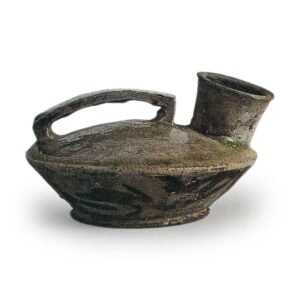
Excavated from SE311B, Heijo Palace Site, Saki-machi, Nara-shi, Nara
8th century
Height 5.7cm, mouth diameter 3.3cm, body diameter 9.1cm, bottom diameter 5.5cm
Nara National Research Institute for Cultural Properties
Hira-bottles are one of the vessel forms with a long history, appearing around the end of the 6th century and being produced until the 11th century. The fact that the neck is attached near the edge of the upper surface of the body clearly indicates that it was used as a liquid container. It is known from examples found with inkstones that small flat bottles were sometimes used as water droplets for brush and ink writing. This vessel has four characters written in ink on the sides of the body and one character written in ink on the underside, but the characters themselves are not fully legible.
However, three of the four characters on the side are repetitions of the same character. It may be a study in haphazard style. This flat vase, which is not necessarily small in size, may have been used as a water drop. The handle and upper surface of the body are covered with dark green ash glaze. Judging from the flattened body with a small base and the tension of the base, it was made around the end of the 8th century. It is a fine example of the type of ceremonial ware that was brought to the center of Japan as part of the Owari Shougongsi ware.



